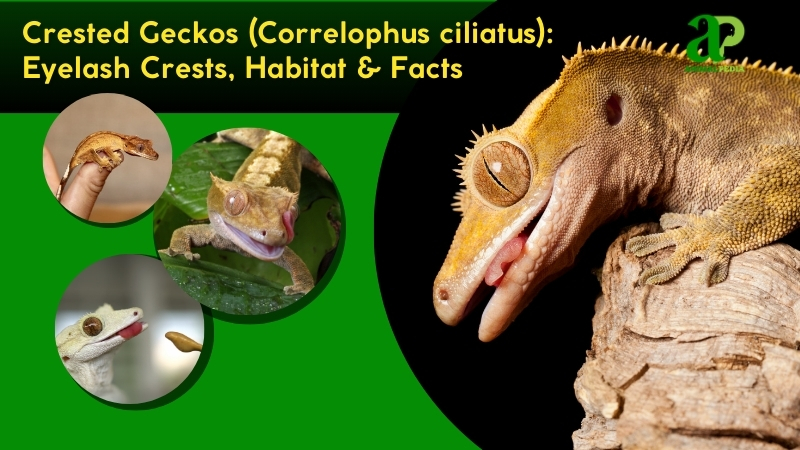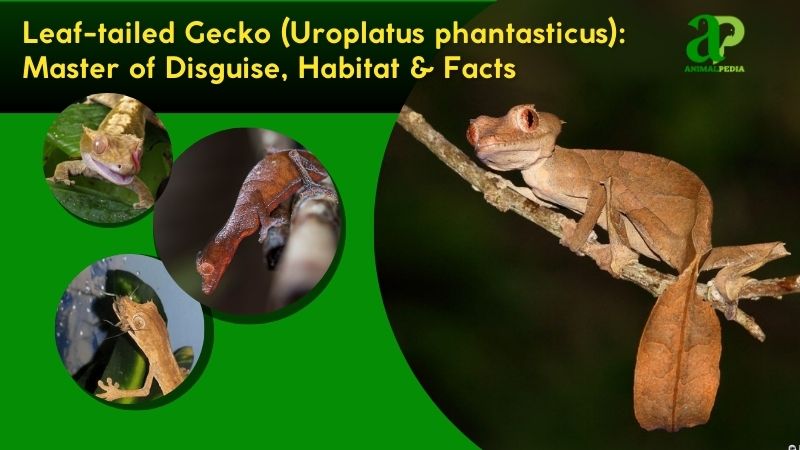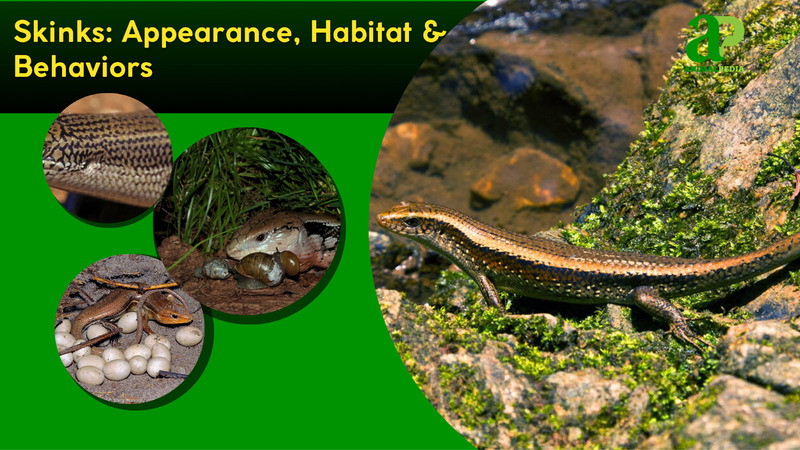The Common House Gecko, Hemidactylus frenatus, is a small, adaptable lizard known for its commensal relationship with humans. As a member of the Gekkonidae family and Squamata order, this nocturnal reptile has a slender physique, typically measuring 3 to 5.3 inches (7.5 to 13.5 centimeters) in total length and weighing between 0.1 and 0.35 ounces (3 to 10 grams).
While native to Southeast Asia, the species has become one of the most widespread geckos globally, establishing populations on multiple continents and Pacific islands, a spread largely attributed to human-mediated transport via ships and cargo (11). Despite its extensive distribution, the Common House Gecko maintains a stable population and is classified as a species of Least Concern by the IUCN Red List.
This comprehensive guide examines the unique physical and biological characteristics of the House Gecko, including the specific adaptations that allow it to thrive in diverse environments. We will explore its behavior, from its nocturnal hunting habits to its ecological role.
By providing a clear and scientifically grounded overview of this lizard, this article aims to provide a deeper understanding of what makes it so successful, whether it is a beneficial insect controller or a competing invasive species.
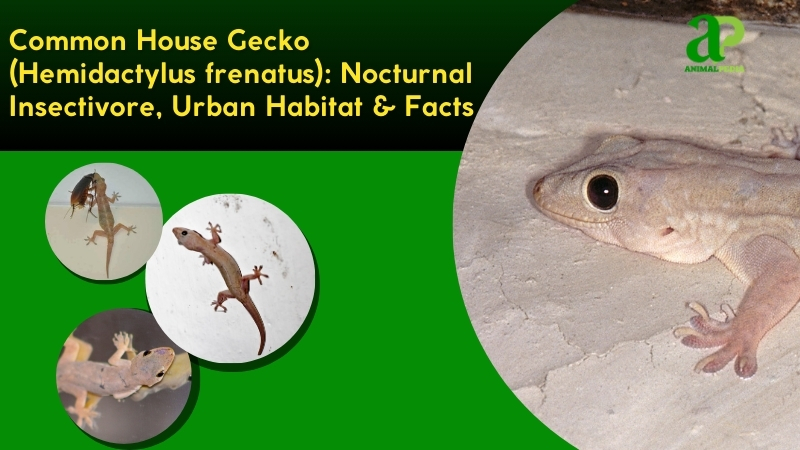
What Are House Geckos?
The Common House Gecko, a type of commensal lizard from the Gekkonidae family, is a highly successful reptile known for inhabiting human dwellings across its global range. The species is classified within the Squamata order and Reptilia class, and its scientific name, Hemidactylus frenatus, directly references its physical characteristics. “Hemidactylus” means “half finger,” and “frenatus” alludes to a bridle-like facial pattern.
While often viewed as a singular species, some researchers argue that high genetic diversity in its native Southeast Asian range may indicate a species complex (11). Scientific research has also examined the gecko’s invasive impact, debating whether the displacement of native species is a result of direct aggression or indirect competition for resources like insects clustered near artificial lights (4).
Known by several common names, including the Asian House Gecko, Bridled House Gecko, and Moon Lizard, the animal’s various titles reflect its geographic origin, physical markings, and its nocturnal habits. Its frequent presence on walls and ceilings in homes has earned it the simple but descriptive names of House Gecko and House Lizard.
A close taxonomic relative, Hemidactylus mercatorius, has been the subject of cytogenetic analysis to infer the evolutionary dynamics of geckos within this genus (15). This foundational knowledge of the species’ identity and classification provides a context for understanding its distinct physical traits. We’ll examine these physical traits next.
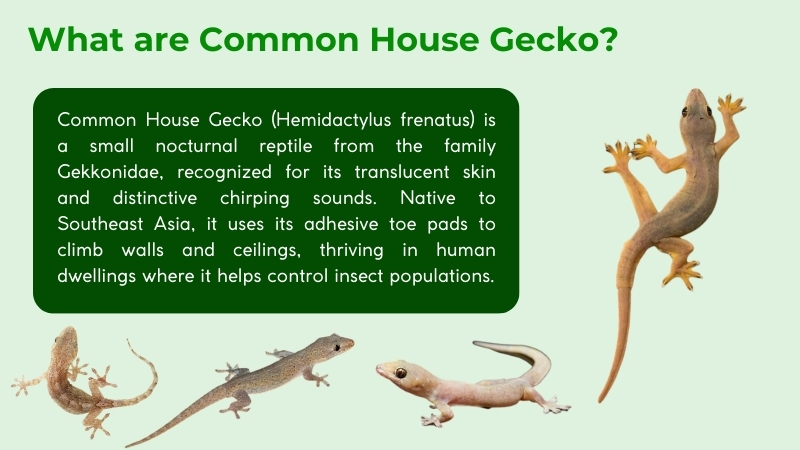
What Do House Geckos Look Like?
The House Gecko has a slender and flattened body, a physical form optimized for navigating narrow crevices. The average male reaches a total length of 5.3 inches (13.5 cm), while females are slightly smaller at 4.9 inches (12.4 cm). The gecko’s skin is grayish to pale brown with darker flecks or mottled patterns, providing effective camouflage against various surfaces.
Unlike many reptiles, its skin is smooth to the touch, and it features small, inconspicuous tubercles on its back. The underside is a lighter color. The head is triangular and flattened with large, golden-brown eyes that have vertical pupils and no eyelids, covered by a clear nictitating membrane for protection. Small, sharp teeth in a short jaw are designed for grasping insects, which the gecko detects with its small nostrils.
The gecko’s most notable physical adaptation is found on its limbs. Its four short legs are equipped with toe pads that feature millions of microscopic hairs called setae. These structures create a temporary bond with surfaces through van der Waals forces, allowing the gecko to cling to and traverse vertical surfaces and ceilings (1). The cylindrical tail is covered with spine-like scales and can be shed in a process of autotomy to escape predators.
The tail regenerates in about 30 days, a process involving the coordinated expression of hundreds of genes and proteins (14). Males can be distinguished from females by their slightly larger size and the presence of femoral pores, which are used to secrete scents for marking territory. Understanding their appearance is one thing; now we’ll examine the gecko’s actual size.
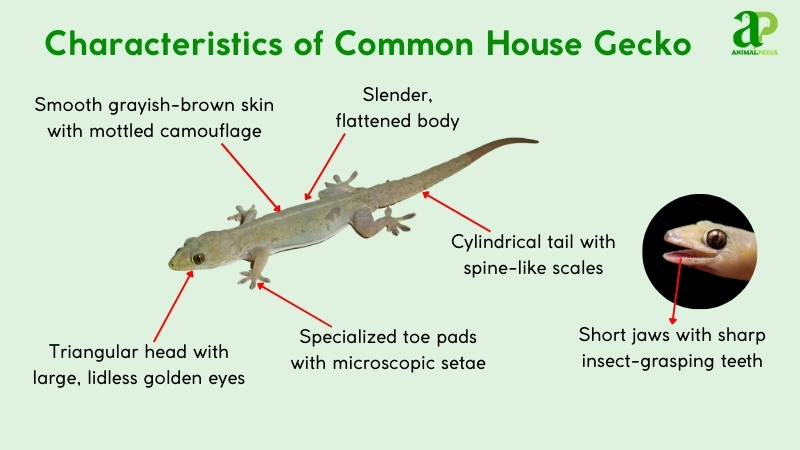
How Big Are House Geckos?
The adult House Gecko typically has a total length ranging from 3 to 5.3 inches (7.5 to 13.5 cm) from its snout to the tip of its tail. As with many species, a gecko’s size is influenced by its developmental stage. Hatchlings begin at a length of only 0.8-1.2 inches (2-3 cm) in length, maturing into juveniles at 1.6-2.4 inches (4-6 cm), and reaching adult size in approximately 6 to 12 months.
The species exhibits sexual dimorphism, with males being slightly larger and heavier than females. The size difference is noticeable, as shown in the table below, which provides a breakdown of average measurements for both genders. These small creatures are comparable in size to a common house key.
| Feature | Male Average | Female Average |
| Total Length | 5.3 inches (13.5 cm) | 4.9 inches (12.4 cm) |
| Weight | 0.1-0.35 oz (3-10 g) | 0.1-0.35 oz (3-10 g) |
| Snout-Vent Length | 2.6 inches (6.5 cm) | 2.4 inches (6.0 cm) |
Their small size is key to their success, a success that has taken them across the globe. Let’s explore where they live.
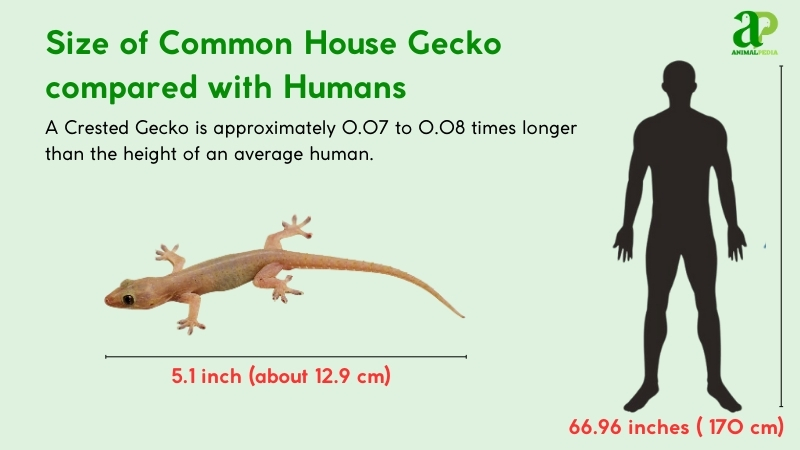
Where Do House Geckos Live?
The House Gecko’s native distribution is in Southeast Asia, but its range now extends across the globe, including significant populations in the Americas, Africa, Australia, and the Pacific islands (8). This extensive, human-aided spread has made it a cosmopolitan species, thriving in environments that other reptiles cannot survive in.
The gecko is highly adaptable to human-altered habitats and is a quintessential urban reptile, often found in buildings and on walls near artificial light sources that attract its insect prey.
While its urban presence is well-documented, the species also occupies natural lowland habitats, including rainforests, deserts, and plantations, where it benefits from a tropical climate. The gecko requires temperatures between 68 and 86°F (20 and 30°C) and a relative humidity of 60-80% to survive.
A 2018 study projected that climate warming could expand the House Gecko’s habitable range by 8-95% by 2050 (12). Males are highly territorial and defend their spaces from rivals through a combination of chirps and other vocalizations (9), as well as physical posturing, which establishes dominance. A wide range is a testament to the House Gecko’s behavior, which contributes significantly to its survival.
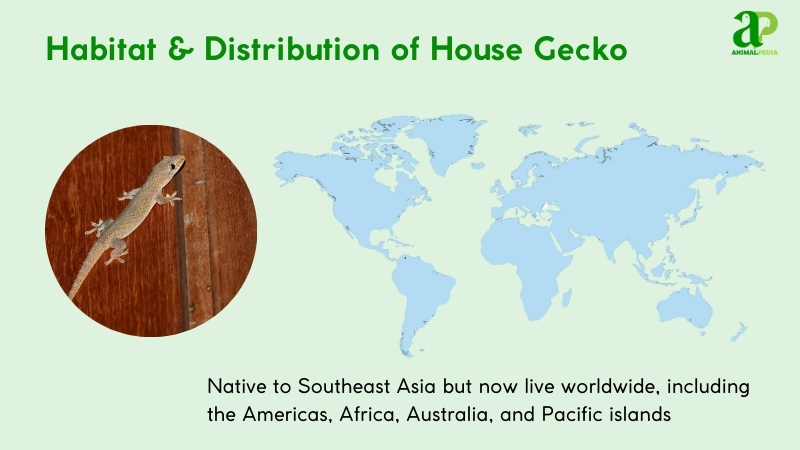
How Do House Geckos Behave?
The Common House Gecko demonstrates a variety of behaviors that have contributed to its success as a widespread species, including its nocturnal hunting strategy, agile movement, and strong territorial defense. Its behavioral patterns are defined by a singular focus on survival, reproduction, and the efficient exploitation of its environment, particularly in human-modified landscapes.
- Diet and Feeding: The House Gecko is an opportunistic insectivore that ambushes its prey, contributing to natural pest control.
- Movement and Abilities: This reptile uses specialized toe pads and tail autotomy to move with speed and agility on a variety of surfaces.
- Daily/Seasonal Patterns: Its activity is primarily nocturnal, with specific behaviors tied to daily light and temperature cycles rather than seasonal migration.
These key behaviors highlight the gecko’s adaptive nature, which will be explored in greater detail in the following sections.
Diet and Feeding
The Common House Gecko is an opportunistic insectivore feeding primarily on arthropods. Its diet is composed of about 90% insects, with the remaining intake consisting of other invertebrates like spiders. This makes the gecko a natural and effective pest controller in its environment, preying on common household pests such as roaches, mosquitoes, and moths.
As a nocturnal hunter, the gecko typically employs an ambush strategy, remaining still on walls or ceilings near light sources to wait for its prey to approach. Once an insect is within striking distance, the gecko makes a quick burst of movement to capture it with its tongue and small, sharp teeth.
Although insects are its primary food source, documented cases of cannibalism have been observed, where larger geckos consume smaller individuals, a behavior not uncommon in the reptile kingdom. Beyond their feeding habits, the House Gecko’s movement and physical abilities are equally.
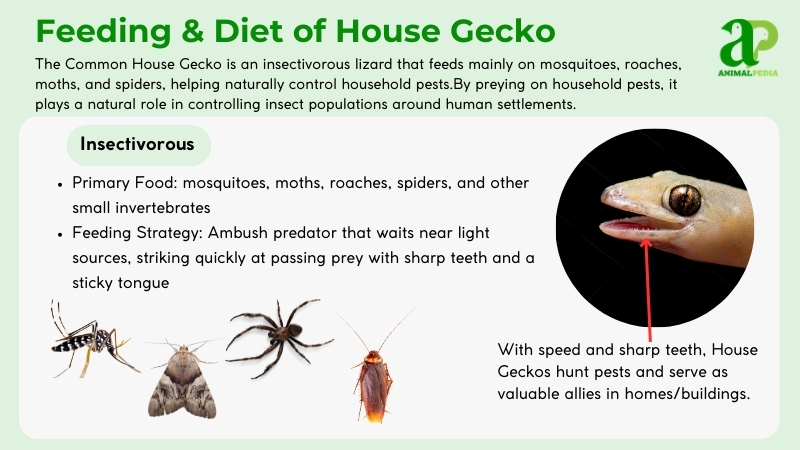
Movement and Abilities
The House Gecko moves with agility, primarily through running, climbing, and jumping. Its ability to navigate vertical and horizontal surfaces is unparalleled. The gecko can run at speeds up to 12.4 miles per hour (20 km/h) (1).
The species’ most notable physical capabilities are its specialized toe pads and the ability to drop its tail. The toe pads are equipped with millions of microscopic, bristle-like hairs called setae, which use van der Waals forces to create a temporary bond with surfaces, allowing the gecko to cling to walls and ceilings without slipping (1).
The gecko can also shed its tail in a process known as autotomy when threatened by a predator, a defensive behavior that allows it to escape. The detached tail continues to writhe for several minutes, distracting the attacker while the gecko flees. The tail regenerates in about 30 days. Their physical agility is complemented by a consistent pattern of daily and seasonal activity.
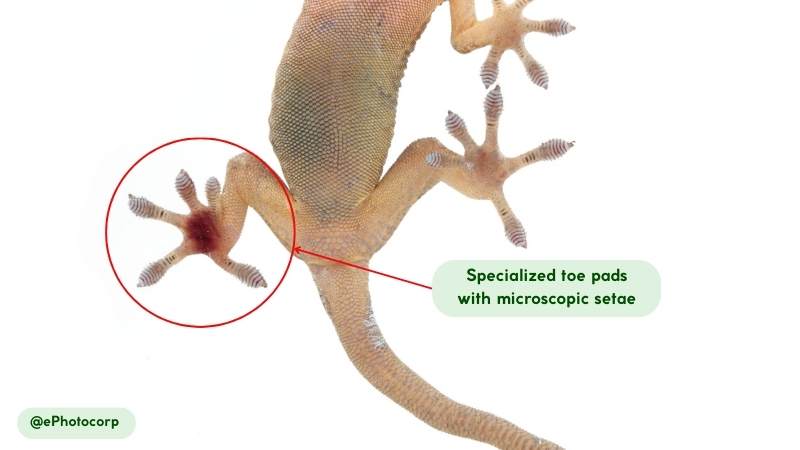
Daily/Seasonal Patterns
The House Gecko is a nocturnal reptile, with its daily activity beginning after dusk and ending before dawn. Its cycle is defined by a distinct timeline of activity.
- Dusk (18:00 – 20:00): The gecko emerges from its shelter in walls, behind pictures, or in crevices to begin foraging.
- Night (20:00 – 04:00): The gecko is most active during this period, hunting for insects near artificial light sources and vocalizing to communicate with other geckos (9).
- Dawn (04:00 – 06:00): As light returns, the gecko retreats to its daytime shelter to rest and digest.
The species does not undergo a significant seasonal migration. Its behavior and activity levels are influenced more by daily temperature and light cycles than by seasonal changes. In cooler climates, the gecko may enter a state of reduced activity known as brumation, but it does not fully hibernate.
Its ability to thrive in urban environments with stable temperatures also reduces its reliance on seasonal changes. These daily cycles are critical for survival and also play a role in their reproductive success.
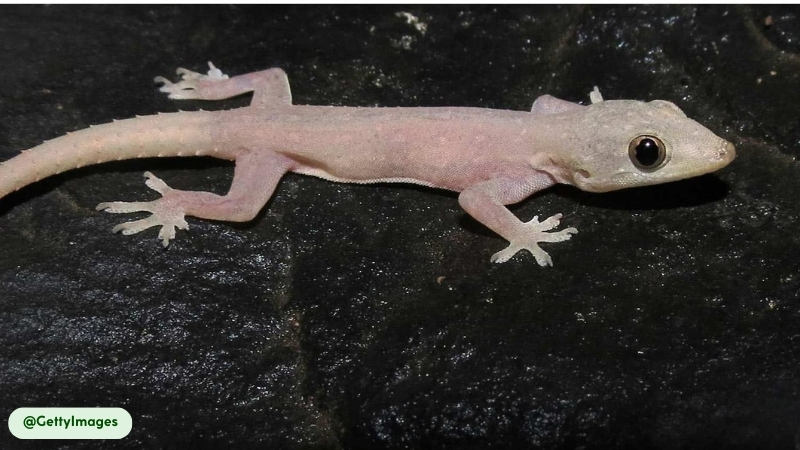
How Do House Geckos Reproduce?
The House Gecko is an oviparous species, which means it reproduces by laying eggs. Mating can occur year-round in tropical and subtropical regions where the climate is consistently warm, but it typically peaks during the humid months. Courtship involves the male performing a series of chirps and bobs to attract a female and assert dominance over other males. A female can store sperm and produce multiple clutches from a single mating.
Following a gestation period of approximately three weeks, the female lays a clutch of two eggs. The eggs are hard-shelled and are often laid in protected locations, such as wall crevices, under furniture, or in abandoned burrows, where they are attached to a surface with a sticky secretion.
The incubation period lasts between 45 and 60 days, depending on the environmental temperature. The sex of the hatchling is determined by the incubation temperature, a phenomenon known as temperature-dependent sex determination (5). House Geckos do not exhibit any form of parental care; once the eggs are laid, the parents do not tend to the nest or the young. Reproduction ensures the species’ continuation; next, we will examine the typical lifespan of a House Gecko.

How Long Do House Geckos Live?
A House Gecko lives for approximately five years in the wild. Its longevity is influenced by a number of factors, including the availability of food, predation risk, and the stability of its habitat. In captivity, with proper care and a controlled environment, a gecko’s lifespan can be extended to as much as 8 years or more (2, 7). This extended lifespan is directly tied to the elimination of external threats and consistent access to resources.
A gecko reaches sexual maturity in about six months to one year after hatching (3, 6). The short maturation period, combined with its ability to lay multiple clutches of eggs annually, supports its high reproductive rate. This rapid lifecycle is a key factor in the species’ ability to colonize new territories and maintain robust populations. Given their long lives and ability to thrive in human environments, their impact on people is worth examining.
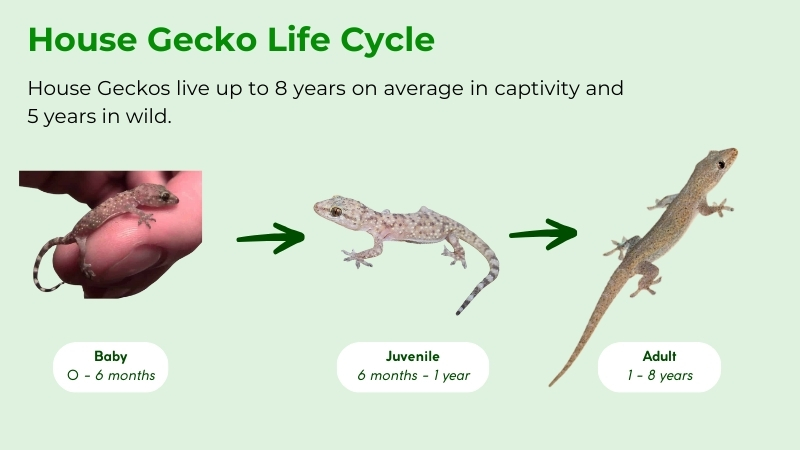
Are House Geckos Harmful/ Beneficial to Humans?
House Geckos are primarily beneficial to humans. The species is a natural and effective pest controller, consuming a wide range of household insects and other invertebrates. Its diet often includes common pests such as cockroaches, mosquitoes, and moths, which helps reduce their populations indoors (16).
In some Southeast Asian cultures, the gecko’s presence is considered a sign of good fortune and prosperity, and its chirping calls are often regarded as auspicious omens. The gecko’s role as an insectivore, combined with its cultural significance, highlights its positive relationship with people.
However, this relationship is not without its complexities. While beneficial for insect control, the house gecko’s status as an invasive alien species in new areas can cause ecological problems. They can compete with native reptiles for food and shelter, and in some cases, can become predators of smaller lizard species (4, 11).
Research indicates that this impact is not always direct; sometimes, the competition is indirect, with the house gecko attracting edible insects to artificial light sources, reducing the food supply for native species. This makes their role in new ecosystems not just beneficial but also potentially detrimental. The gecko’s role in our homes is complex, and a key aspect of that is whether they pose any physical danger.
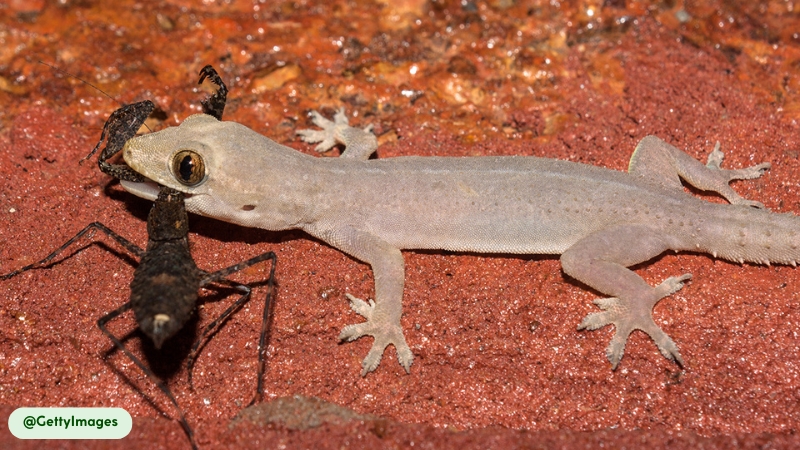
Are House Geckos Poisonous?
House geckos are not poisonous. The species is completely harmless to humans, as it lacks venom glands and does not produce any toxins (16). Although a gecko may bite if it feels threatened or cornered, its small jaw and fine teeth mean that a bite is not medically significant and rarely breaks the skin. The gecko’s primary defensive behaviors are to flee from a threat or to drop its tail to distract a predator. The best course of action upon encountering a gecko is to leave it undisturbed.
When a gecko bites, it is typically a defensive reaction rather than an act of aggression. If a person attempts to hold or catch a gecko, it may bite to get away. A bite usually does not require medical attention, and symptoms, if any, are a minor nip or a scratch. In such cases, cleaning the wound with soap and water is sufficient.
It is important to understand that biting behavior is a self-protective reflex of the animal, and staying away from them is the safest guideline when interacting. With their ability to coexist with humans and a lack of toxicity, the gecko’s status in the wild remains a popular topic.
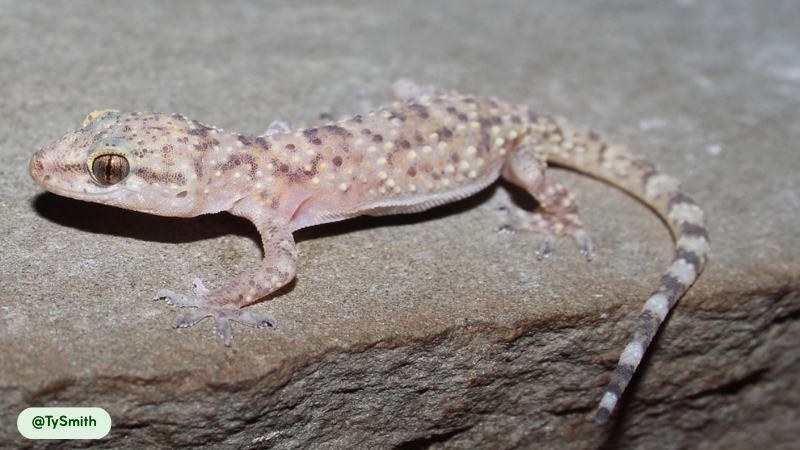
Are House Geckos Endangered?
House geckos are not an endangered species. The Common House Gecko is listed as a species of Least Concern by the IUCN Red List due to its extremely wide distribution, its large and stable population, and its adaptability to human-modified habitats.
The species is highly successful, and its populations are not experiencing a decline (11). Instead of facing threats to its survival, the gecko’s rapid expansion is considered a challenge to the ecosystems it invades.
The House Gecko’s prolific ability to colonize new territories, often by stowing away on ships and cargo, makes it a competitor for native fauna. For example, research has shown that in some island ecosystems, these geckos can outcompete and displace native gecko species by dominating food sources clustered around light and by preying on smaller lizards (4).
Individuals can support ecological balance by preventing the accidental transport of geckos to new areas, especially sensitive environments. Their conservation status is secure, but there is still much to learn about these reptiles. Discover more about their unique behaviors and traits.
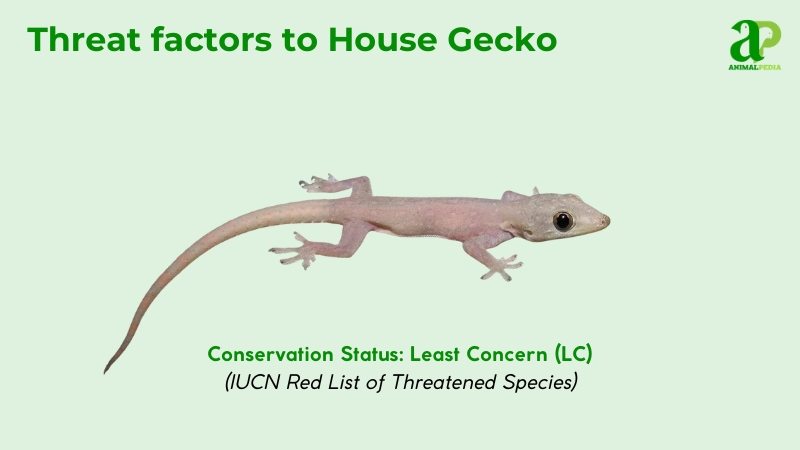
Fascinating Facts About House Geckos
- Communal Egg-Laying. Female House Geckos often lay their hard-shelled eggs in communal nesting sites. These shared locations, which can be in wall crevices or behind furniture, may contain dozens of eggs from multiple females. This behavior provides a degree of protection and thermal stability for the developing embryos.

- Exceptional Vocalizations. The Common House Gecko is one of the more vocal lizard species. It produces a distinct series of chirps and clicks that serve as a form of communication. These vocalizations, which are often heard at night, are used to attract mates, establish territorial boundaries, and warn off rival males (9).

- Microscopic Adhesion. The gecko’s renowned ability to walk on walls and ceilings is not due to suction, but rather a mechanism involving weak intermolecular forces. Its toe pads are equipped with millions of microscopic, bristle-like hairs called setae (1), each branching into hundreds of even smaller structures. This creates a large surface area that interacts with surfaces at a molecular level, allowing the gecko to adhere to almost any substrate.
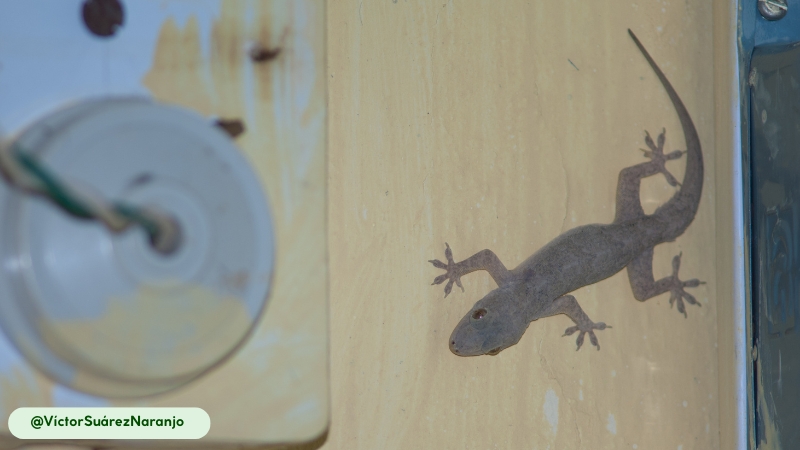
- Autotomy and Regeneration. When a gecko feels threatened, it can voluntarily detach its tail in a defensive act known as autotomy. The detached tail continues to writhe, creating a distraction that allows the gecko to escape. Recent research has shown that the regeneration of a new tail involves the coordinated expression of hundreds of genes and proteins, with the full structure regenerating in approximately 30 days (14).

- Lidless Eyes. House geckos lack eyelids and therefore cannot blink. Their large, unblinking eyes are protected by a transparent, fixed scale, or spectacle. To keep their eyes clean and moist, they use their tongues to lick the spectacles, an unusual behavior that is a hallmark of their species.
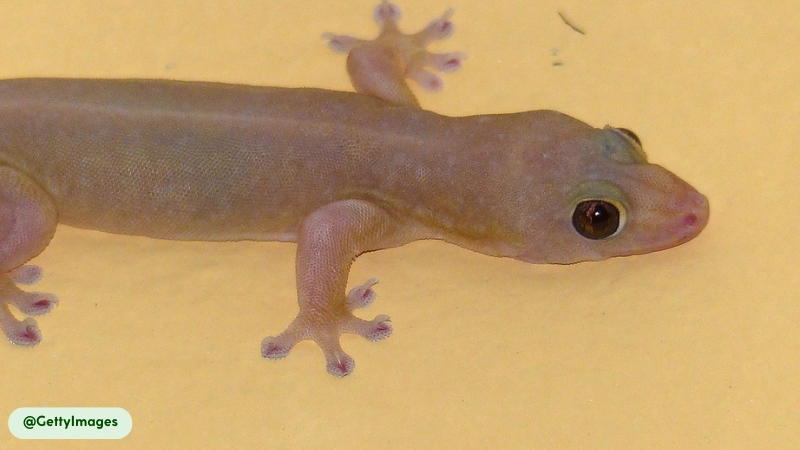
- Temperature-Dependent Sex Determination. The sex of a House Gecko hatchling is not determined genetically. The temperature at which the egg incubates is the determining factor, a process known as temperature-dependent sex determination (TSD) (5). Warmer temperatures generally produce males, while cooler temperatures result in females.
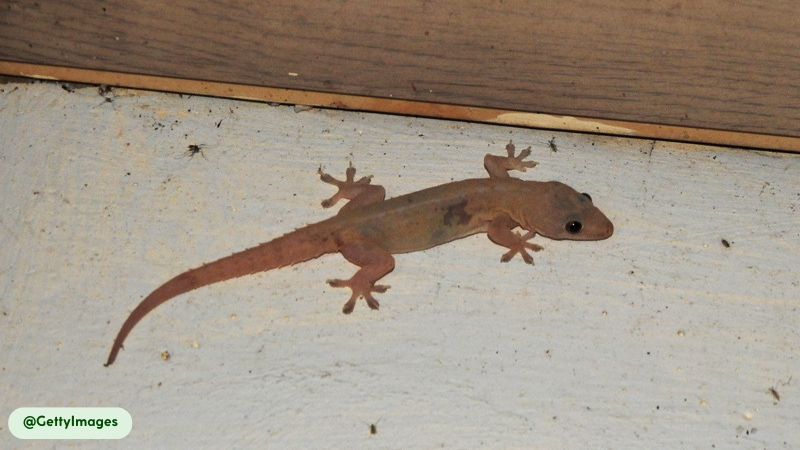
- Global Travelers. The Common House Gecko’s global distribution is largely a result of human activities. The species has been transported unintentionally via cargo, stowing away on ships and in goods, allowing it to colonize new continents and island ecosystems far from its native Southeast Asian range (11).
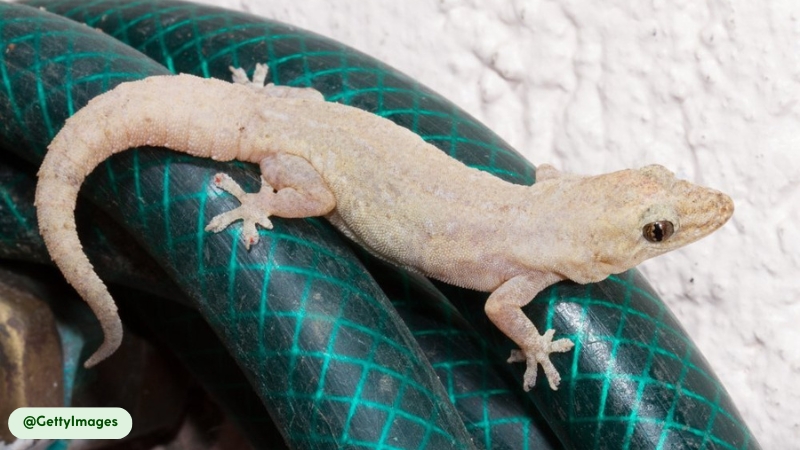
- Efficient Predator. As an opportunistic insectivore, the House Gecko is a highly effective predator of household pests. Its ambush hunting strategy, often performed near artificial light sources, enables it to capture prey with a rapid burst of speed and a high success rate. This makes the gecko a natural form of pest control in homes.
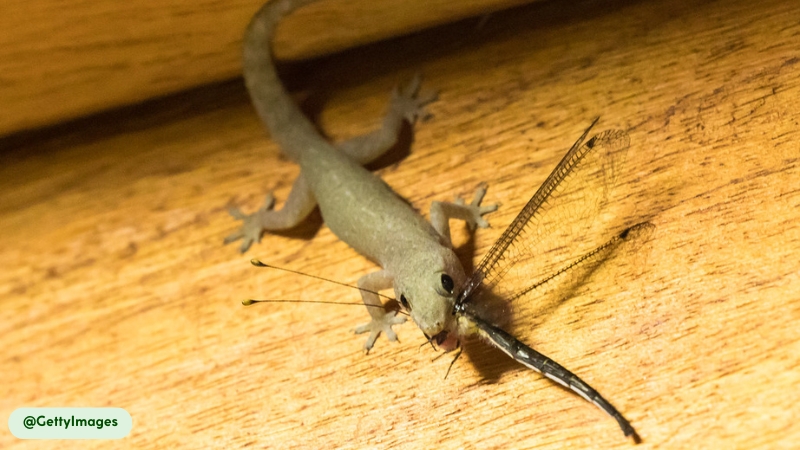
- Cannibalistic Tendencies. While primarily insectivores, House Geckos have been observed to exhibit cannibalistic behavior. In some cases, larger individuals may prey on smaller geckos, particularly juveniles. This behavior, though not a primary source of food, is a documented aspect of the species’ diet.
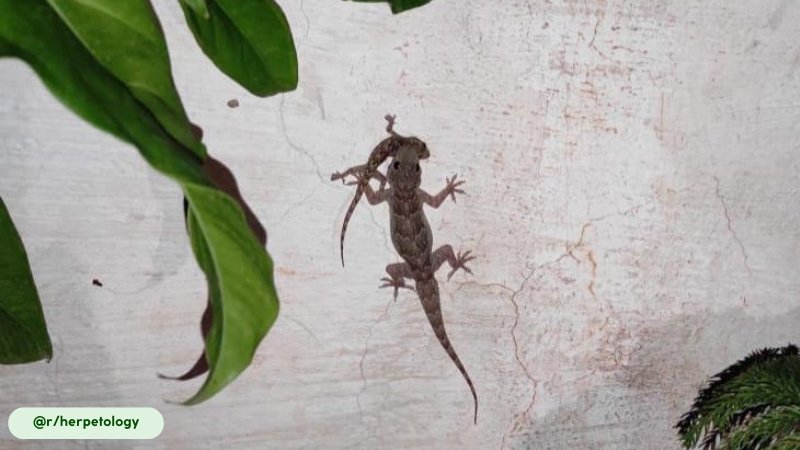
- Skin Consumption. The House Gecko regularly sheds its skin, a process of renewal called ecdysis, which allows for growth and the removal of external parasites. After shedding, the gecko will often consume its own shed skin, a behavior known as dermatophagy. This allows the animal to recover valuable nutrients and moisture that would otherwise be lost. With these facts in mind, we’ll now address some of the most frequently asked questions about House Geckos.
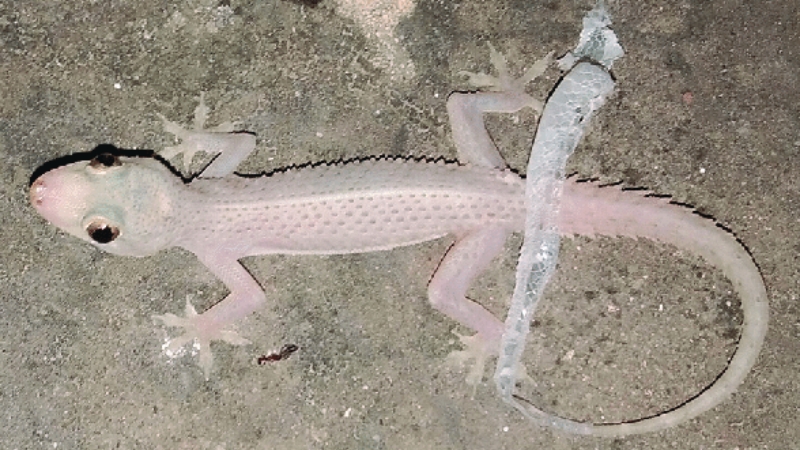
Frequently Asked Questions About House Geckos
Do Mediterranean House Geckos Bite?
The Mediterranean House Gecko, a close relative of the Common House Gecko, rarely bites unless it feels threatened or is handled. The bites are not medically significant. These small reptiles do not possess venom or toxins, so a bite from one is not dangerous.
How Do You Keep Geckos Out Of Your House?
Keeping geckos out involves eliminating their entry points and food sources. Seal cracks and gaps in windows and foundations, and manage household insect populations. Reducing the use of outdoor lights at night can also deter them from coming near your home.
Are Geckos Good Or Bad In The House?
Geckos are beneficial to have in the house. They are natural pest controllers, consuming insects such as mosquitoes, moths, and roaches. Their presence helps reduce the number of other unwanted pests in your living space.
Do Geckos Carry Parasites?
Yes, like any wild animal, geckos can carry parasites. However, the risk of a gecko transmitting parasites to humans is extremely low. Direct contact is the primary way for this to occur, so avoiding handling them is the safest practice.
Conclusion
House geckos, with their intricate adaptations and successful life history, demonstrate the ability of certain species to thrive in a world shaped by humans. From their unique climbing abilities to their role in natural pest control, these small reptiles are a fascinating subject for study. At Animal Pedia, our mission is to provide you with a deeper understanding of the world’s fauna through expertly curated, scientifically accurate, and visually engaging content. We invite you to continue your journey of discovery and explore more about the diverse animal kingdom on our website.





